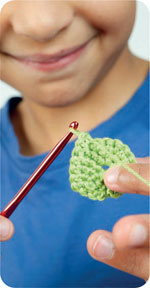
While teaching all kinds of craft workshops for children, I have developed a few priceless and failsafe practices that should ensure that crochet will become a fun hobby for any young child. Even if you do not follow them all rigidly, I recommend you stick at least to the simple tools and materials and have a play with the techniques and tips to find out what your child enjoys crocheting.

Your first question is probably, what is the best age to begin teaching your child how to crochet? The truth is, there is no perfect age, as it depends on the individual. It is possible to learn the very basics as young as four or five, if your child has highly developed motor skills and is used to doing arts and crafts with you. However, I have found that the best age is seven or eight, as by this time most children are dexterous enough, have good hand-eye coordination and can concentrate for longer periods of time. They will also be more likely to take all the techniques in and adopt crochet as a hobby and skill that they never forget.
Crochet can be fiddly to learn, due to the need to hold the yarn correctly, so to gauge whether you think your child may be ready to learn, the best thing to do is to teach them to create long lengths of chain. The basic crochet stitches can be quite tricky to master at first and are nearly impossible if you have not first perfected the trick of holding the yarn to create an even tension. The good news is that once the tension is mastered, the stitches can be picked up very quickly, as each stitch builds upon the last. So encourage your child to practice getting the perfect tension by making long lengths of basic chain until you feel that they are ready to move onto the stitches. The chains can easily be made into necklaces or friendship bracelets so that your child doesn’t feel as though making them is a fruitless activity.
When choosing tools and materials, there are a few pointers to follow to make them more desirable to young fingers. Metal or metal-tipped hooks are the best kind to use, as the shank is smooth and slippery and the hook is well defined, which means the yarn will slip over the tip more easily and stitches will not snag as much. If you look around, you can find brightly coloured hooks, or sparkly ones, which should make them instantly desirable to the young eye. It is also best to work on projects that use medium-thickness hooks, of around 3–5mm, so that children are not working with stitches that are too small and intricate, or with hooks that are too unwieldy.
Traditionally cotton is assumed to be the only fibre for crochet. However, any yarn can be used, so long as it is smooth and not a fancy yarn, such as a bouclé. In fact, for the first project a traditional crochet thread can be a bit thin, hard and uncomfortable to use, so it is probably best to use a smooth and stretchy, relatively cheap yarn, such as wool or acrylic, as this will be easier on the child’s hands and the project will ‘grow’ more quickly.
Go slowly with your child at first, they are generally happy just playing with the yarn and techniques – make the learning like a game. Try to vary the activity as you teach, so have pompom makers and sewing needles to hand to embellish the fabric and break up the monotony of the crochet stitches, especially when you notice any concentration lapses. Don’t make them crochet for too long, especially at first. It is a repetitive skill, which can cause unpracticed hands to ache. Short, fun lessons with breaks will stop children feeling that they are being forced to crochet and will make them look forward to picking up the hook again. You do not have to practice every day, so long as you crochet regularly. Perhaps you can find time to crochet during a favourite cartoon or before bedtime to unwind. Maybe Saturday evenings will be craft time. Any quality time with mum, dad or grandma will be eagerly anticipated and if you include all your children in some way, and even their friends, they will want to do it more as it will be something they can share and talk about.
Have patience with your child; it seems patronizing to say so, but sometimes after a long day together a parent can often be less patient with his or her own child, especially if they really want the child to share in the love of something dear to them. Even if a terrible mess is occurring, try not rip back a child’s work too far, which can undermine their confidence in their ability – let them see their progression from wonky fabrics with sloping sides to beautiful, even crochet.
The best tip I can give you is: make it fun! While an adult will happily crochet large projects, children want to see results quickly or they may get bored or lose concentration. Small projects such as a belt or toy – or those that are made up of motifs such as granny squares – are preferable to the failsafe adult beginner project, the scarf. Crochet should always be relaxing and fun, otherwise what’s the point? So ensure you both enjoy the process and do not put too much emphasis on perfectly finished fabrics. Be flexible and encourage your child to use their imagination; projects can evolve as they are made, developing into a final piece dictated by the shape of the fabric. Every child is different and they have a very different view of the world to adults, so let them form fabulous creations from their fabrics and perhaps in return they can teach you a thing or two about crochet!
